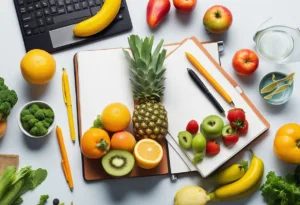Keeping a food journal is a useful way to track eating habits and improve nutrition. It is a simple and effective way to monitor daily intake and make adjustments as needed. By recording what is consumed throughout the day, individuals can identify patterns and make changes to their diet to improve their overall health. In this blog post I will share with you 35 food journal ideas to help you get started on your food journaling journey.
There are many food journal ideas that can be used to help individuals track their eating habits. Some people prefer to use a traditional notebook to record their meals, while others use a digital app or website. Regardless of the method used, it is important to be consistent and accurate when tracking food intake. This can help individuals identify areas where they may be consuming too much of certain foods or not enough of others.
Mindful eating is another important aspect of maintaining healthy eating habits. By paying attention to the taste, texture, and smell of food, individuals can become more aware of their eating habits and make better choices. Food journaling can help individuals practice mindful eating by encouraging them to slow down and pay attention to what they are consuming. By combining food journaling with mindful eating practices, individuals can improve their overall health and wellbeing.
Setting Up Your Food Journal
Keeping a food journal is an excellent way to track your eating habits, monitor your progress towards weight loss goals, and identify any food sensitivities. Here are some tips on how to set up your food journal:
Choosing the Right Medium
When it comes to food journaling, there are several options available. Some people prefer to use a traditional pen and paper, while others prefer a digital medium. There are also specialized food diary apps and websites that can be used to track your meals. Consider your preferences and choose the medium that works best for you.
Structuring Your Entries
To make your food journal effective, it’s important to structure your entries in a way that works for you. Some people prefer to write down everything they eat, while others prefer to track specific macronutrients or food groups. Whatever method you choose, make sure to be consistent and accurate in your entries.
Incorporating Meal Planning and Grocery Lists
Meal planning and grocery lists can be excellent additions to your food journal. By planning your meals in advance, you can ensure that you are eating a balanced diet and avoid impulse purchases at the grocery store. Consider incorporating a section in your food journal for meal planning and grocery lists.
Setting up your food journal is a simple process that can yield significant benefits in terms of your health and nutrition. By choosing the right medium, structuring your entries, and incorporating meal planning and grocery lists, you can make your food journal a valuable tool in your overall wellness journey.
35 Food journal ideas
Here are 35 food journal ideas you can use:
- Daily meal tracker for breakfast, lunch, and dinner
- Weekly meal planning spreads
- Grocery shopping lists organized by food groups
- Recipe pages for favorite or new dishes
- Food mood tracker to see how what you eat affects your mood
- Calorie count logs for each meal
- Water intake tracker to ensure proper hydration
- Snack logs to monitor between-meal eating
- A chart of in-season fruits and vegetables
- Food group goals to balance your diet
- Favorite healthy recipe collection
- Eating out log to track meals from restaurants
- Cooking challenge tracker for trying new recipes
- Portion size guide for common foods
- Monthly summary to review progress and patterns
- Vitamins and supplements log
- Food waste diary to minimize waste
- Intermittent fasting tracker
- Emotional eating journal to record feelings associated with eating
- Kitchen inventory to keep track of pantry items
- Budget tracker for grocery spending
- Food allergy or sensitivity tracker
- Homemade vs. store-bought food comparison
- Nutrient tracker focusing on specific vitamins or minerals
- Sugar intake log
- Meal prep planner for the week
- Cheat day log to enjoy and track indulgences
- Leftovers tracker to ensure food isn’t forgotten
- Inspirational quotes or goals for healthy eating
- Seasonal recipe section for maximizing fresh produce
- Food photography page to visualize appealing meals
- Farmer’s market finds and their uses
- Smoothie and juice recipe collection
- Cultural food exploration diary
- Detox or cleanse tracker for specific diets
These ideas can be customized and combined to create a food journal that suits your personal goals and lifestyle.

Tracking Your Diet
Keeping a food journal is an effective way to track your diet and monitor your nutritional intake. By logging food intake, you can identify unhealthy eating habits and make necessary changes to your diet. Here are some ideas for tracking your diet:
Logging Food Intake
One way to track your diet is by logging your food intake. This can be done using a food journal or an online diet journal. In a food journal, you can write down the types of food you eat and the beverages you consume.
You may also include the kind of food preparation (fried, broiled, etc.) and the condiments used, if any. Online diet journals can help you track 21 nutrients for 200,000+ foods and 3000+ brands. They can also help you count calories, log exercise, and much more.
Understanding Portion Sizes
Understanding portion sizes is crucial when tracking your diet. Measuring cups and food scales can help you accurately measure the amount of food you are consuming. It is also important to pay attention to serving size and weight or volume of the food you are eating. By understanding portion sizes, you can better control your calorie intake.
Identifying Nutritional Content
Identifying nutritional content is essential when tracking your diet. Paying attention to the nutritional content of the food you are eating can help you make informed decisions about your diet. Nutritional content includes protein, fat, carbs, sugar, fiber, vitamins, and calories. By identifying the nutritional content of the food you are eating, you can ensure that your diet is well-balanced and meets your nutritional needs.
Tracking your diet is an effective way to monitor your nutritional intake and make necessary changes to your diet. By logging food intake, understanding portion sizes, and identifying nutritional content, you can improve your eating habits and maintain a healthy diet.
Analyzing Eating Patterns
Recognizing eating patterns is a crucial step in maintaining a healthy relationship with food. By analyzing eating patterns, one can identify the triggers that lead to overeating and emotional eating. The following subsections will provide insight into recognizing emotional eating, adjusting for health and fitness goals, and connecting food and mood.
Recognizing Emotional Eating
Emotional eating is a common phenomenon where individuals tend to eat to cope with negative feelings such as stress, anxiety, or sadness. By recognizing emotional eating patterns, one can take steps to manage negative emotions without resorting to food. Some ways to recognize emotional eating patterns include keeping a food journal, identifying triggers, and finding alternative coping mechanisms.
Adjusting for Health and Fitness Goals
Adjusting eating patterns to meet health and fitness goals is an essential aspect of maintaining a healthy lifestyle. Whether the goal is to lose weight, gain weight, or improve overall nutrition, tracking food intake can help achieve these goals. By keeping a food journal, one can monitor food intake, identify areas for improvement, and make necessary adjustments.
Connecting Food and Mood
Food and mood are closely interconnected. Certain foods can impact mood and mental health, making it essential to pay attention to food choices. By keeping a food journal, one can identify how food affects mood and make necessary adjustments to promote mental health. Some foods that can impact mood include fatty foods, caffeine, and sugar.
Analyzing eating patterns is a crucial step in maintaining a healthy relationship with food. By recognizing emotional eating patterns, adjusting for health and fitness goals, and connecting food and mood, one can make necessary adjustments to promote overall health and well-being.

Leveraging Your Food Journal for Success
Keeping a food journal is a great way to become more conscious and aware of your nutritional needs. It can also help you develop your creativity in the kitchen. Here are some ways to leverage your food journal for success.
Recipe Development and Creativity
One of the best ways to use your food journal is to jot down recipe ideas and food writing prompts. This can help you develop your creativity and come up with new and exciting dishes. You can also use your food journal to keep track of recipes that you want to try in the future.
Collaborating with Health Professionals
A food journal can be a valuable tool when working with a registered dietitian or other health professional. By tracking what you eat and drink, you can identify patterns and areas where you may need to make adjustments to your diet. This information can be used to develop a personalized nutrition plan that meets your unique needs.
When collaborating with a health professional, be sure to share your food journal with them. This will give them a better understanding of your eating habits and help them make more informed recommendations.
Keeping a food journal is a simple but effective way to improve your diet and overall health. By leveraging your food journal for success, you can develop your creativity in the kitchen and work with health professionals to meet your nutritional needs.
Frequently Asked Questions
How can I effectively track my meals in a food journal?
To effectively track meals in a food journal, it is important to be consistent and detailed. Writing down everything that is consumed, including portion sizes and any snacks or drinks, can provide a clear picture of eating habits. It is also helpful to note the time of day, location, and any emotions or physical sensations experienced during the meal. Using a food tracking app or website can also be a convenient way to keep track of meals and monitor progress over time.
What are the essential components of a food diary?
The essential components of a food diary include the date, time, and location of each meal, as well as a detailed description of the food and portion sizes. It is also useful to note any snacks or drinks consumed throughout the day, along with any physical or emotional sensations experienced during the meal. Including notes on the preparation method and any food allergies or intolerances can also be helpful.
What are some creative bullet journal layouts for meal planning?
Bullet journaling is a popular method for meal planning and can be customized to fit individual preferences. Some creative layouts include weekly meal plans with grocery lists, tracking water intake and exercise, and creating a color-coded system for tracking different food groups. Adding motivational quotes or stickers can also help to keep the meal planning process fun and engaging.
How can I use a food journal to improve my mental health?
Using a food journal to improve mental health can involve tracking emotions and physical sensations during meals. This can help to identify patterns in eating habits and any triggers or emotional connections to food. It can also be helpful to note any positive experiences or feelings associated with healthy food choices. Additionally, seeking the support of a mental health professional can provide additional guidance and support.
What tips do you have for someone starting a daily food journal?
For someone starting a daily food journal, it is important to be consistent and honest with the entries. Starting with small goals and gradually increasing the level of detail can help to make the process more manageable. It can also be helpful to find a supportive community or accountability partner to share the journey with. Celebrating small wins and progress can also help to stay motivated and engaged.
Where can I find printable templates for a bullet journal food log?
Printable templates for bullet journal food logs can be found online through a variety of sources, including Pinterest and Etsy. It is important to choose a template that fits individual needs and preferences, and to customize it as necessary. Creating a personalized template can also be a fun and creative way to make the meal planning process more enjoyable.



